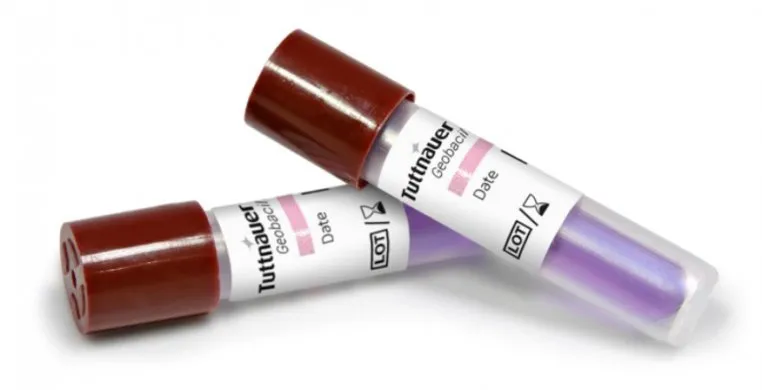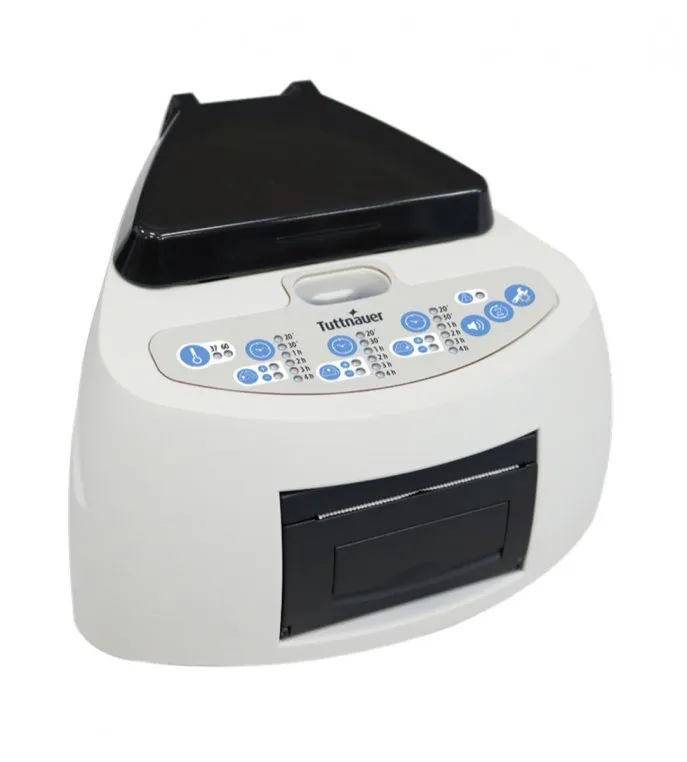Spore testing provides a reliable method for sterility assurance. In autoclaves, the Geobacillus stearothermophilus spore is used. Unlike mechanical or chemical indicators, spore testing determines that spores – the most resistant microorganisms – have been killed during sterilization. In the case of an unpackaged load, it indicates that instruments were sterilized prior to exiting the autoclave.
Options for Spore Tests
In-office and laboratory spore tests are available. In-office spore testing requires use of an incubator and is quicker, while laboratory testing provides independent third-party results. With the availability of digital records for in-office spore testing, verification and results can be logged using digital records/print-outs. Regardless of which type of test is used, spore test and control strips/ampoules must be handled properly as that in itself can cause a spore test to fail. For example, in the case of laboratory testing, failure to make sure the test and control strips are received by the laboratory within the required time of the initial test, or improper handling in the laboratory, causes failure. Spore tests also have a shelf life and in the case of Tuttnauer’s in-office spore tests the shelf life is 2 years. Using spore tests beyond the shelf life is another cause of failed tests.
In-office spore testing procedure
Here we describe the steps required for in-office spore testing using the quickest as our example:
- Select 2 ampoules from the same lot number. One of these will be used in the sterilizer, the other will be the control which will remain outside the sterilizer to check that the spores in the lot were not defective – if the microorganisms in the control ampoule die then something was wrong with the spores since only the test ampoule was in the autoclave during sterilization
- Place the test ampoule in the autoclave per the IFU
- Run the autoclave using the correct cycle and parameters
- Remove the ampoule from the autoclave
- Crush the test and control ampoules to release the enzyme that causes an enzymatic reaction and therefore fluorescence
- Place both ampoules in the incubator for the indicated time
- Read the results for the test and control.

The test is negative, i.e., it was a ‘pass’ result, if the spores from the test vial are killed and the spores from the control vial are alive. The test is positive if the spores in the test vial were not killed (a ‘fail’ result) and categorized as inconclusive if the spores from both vials were killed (also regarded as a ‘fail’).

Why do ‘positive results’ occur for spore tests?
The most common reason for a positive result is air being trapped in the autoclave chamber. Trapped air can be caused by overloading the autoclave, or incorrect loading such as the plastic sides of paper-plastic pouches not all facing in the same direction. These are operator errors. A third reason for a positive result is failure of the autoclave to reach the correct pressure, which can be due to operator error, or autoclave malfunction e.g., failure of vacuum pulses to properly remove air. Other reasons for a failed spore test associated with operator error include manipulating or interrupting cycles, using the wrong cycle parameters or incorrect packaging – e.g., packaging that is too thick or folded, failure to perform maintenance and failure to preheat the autoclave (if indicated). Alternatively, while less common, a positive result may be due to mechanical failure of the autoclave.
| Cause | Due to |
| Trapped air in chamber | Overloading the autoclave – operator error |
| Incorrectly loading the autoclave – operator error | |
| Failure to reach the correct pressure – operator error or autoclave malfunction | |
| Manipulating/interrupting a cycle | Operator error or interruption due to power point issues |
| Using the wrong cycle parameters | Operator error |
| Incorrect packaging | Wrong type/too thick/folded – operator error |
| Failure to perform maintenance | Operator error |
| Failure to perform pre-heating | Operator error |
| Malfunction of autoclave | Issue unrelated to testing and maintenance of the autoclave |
What to do following a positive spore test result
A single positive spore test does not necessarily indicate failure. Further investigation and further spore testing is required. Steps to take include the following:
- Quarantine the loads that were autoclaved during this cycle
- Review mechanical and chemical indicator results for each sterilization cycle since the last negative spore test
- If all required parameters were reached, review potential sources of operator error that could cause spore test failure and correct these. Repeat the spore test using the same autoclave and cycle
- If the second spore result is negative, return the autoclave into service. The most conservative approach is still to reprocess loads processed since the last negative spore test. A less conservative approach is to regard the loads as properly sterilized
- If the second spore test is positive, the sterilizer must be removed from service for maintenance/repair or replaced. If the sterilizer is repaired and returned to service, three consecutive empty-chamber sterilization cycles should first be run, each with a spore test that is found to be negative. In addition, all unused loads that were processed since the last negative spore test must be completely reprocessed.
Note that the requirement for the most conservative approach with respect to loads always applies with implantable devices. For other loads, this requirement varies – be sure to follow the regulations and recommendations for your location.
Conclusions
Spore testing is performed for sterility assurance. Failed spore tests require immediate attention. Based on findings, operator errors indicate a need for training or the autoclave may need to be taken out of service for repairs/replacement. Complete sterilization logs must be maintained, including all sterilization monitoring – both for legal reasons and to enable tracking and reprocessing of affected loads.
Resources
- Association for the Advancement of Medical Instrumentation. ANSI/AAMI ST79: 2017. Comprehensive guide to steam sterilization and sterility assurance in health care facilities.
- Dubai Health Authority. Health Regulation Department. Guidelines on Dental Infection Prevention and Safety.
- Centers for Disease Control and Prevention. Guidelines for infection control in dental healthcare settings – 2003/
- Health Technical Memorandum 01-05: Decontamination in primary care dental practices. (2013)
- Scottish Dental Clinical Effectiveness Programme. Cleaning of Dental Instruments. Dental Clinical Guidance (reviewed 2016)/
About Tuttnauer - We're a one-stop shop for sterile dental processing
Tuttnauer provides end to end sterile processing solutions for dental and medical clinics, including; advanced autoclave sterilizers, thermal washer-disinfectors, indicators and sterile processing products. Our comprehensive line of chemical and biological indicators ensure safe, reliable and timesaving processing and sterilization. Based on decades of infection control knowledge and experience, Tuttnauer delivers a comprehensive range of indicators for the precise monitoring and control of cleaning, decontamination, and sterilization.
For further information and to inquire about purchasing Tuttnauer consumables for your practice, visit the Consumables Section on our website.
